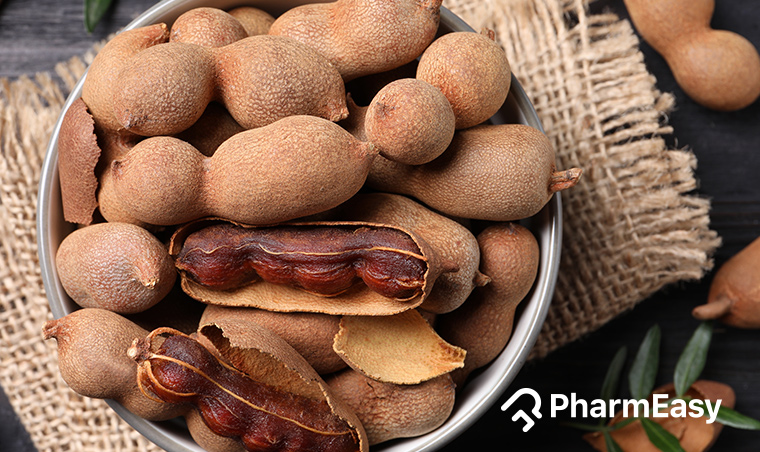Tamarind (Imli): Uses, Benefits, Side Effects and More!
By Dr Rajeev Singh +2 more

Get,

to manage your symptom
Get your,


4 Cr+ families
benefitted

OTP sent to 9988776655



You’ve successfully subscribed to receive
doctor-approved tips on
Whatsapp

Get ready to feel your best.

Hi There,
Download the PharmEasy App now!!


Register to Avail the Offer
Send OTPBy continuing, you agree with our Privacy Policy and Terms and Conditions

Hi There,
Sign up on PharmEasy now!!
Trusted by 4 crore+ families

OTP sent to 9988776655



You have unlocked 25% off on medicines




Code: NU25

Comments


Leave your comment here
By Dr Rajeev Singh +2 more
Table of Contents
Tamarind, scientifically known as Tamarindus indica L., belongs to the family Leguminosae (Fabaceae). It is cultivated almost throughout India1. Tamarind is a multipurpose plant, as almost all parts of the tree are used in the chemical, pharmaceutical, food and textile industries.

Tamarind has good nutritional value. As per the World Health Organization, tamarind fruit is rich in all essential amino acids (except tryptophan). The nutritional value of raw tamarind per 100 grams is as follows2:
Tamarind is a rich source of many phytochemicals and essential amino acids, and hence, it may have many properties and potential uses, including tamarind benefits for health. The potential properties of tamarind are given below.
Tamarind (Imli) may be helpful for many health conditions because of its high nutritional value and potential properties. When exploring the tamarind’s benefits, it’s essential to understand its potential use for various health conditions and organ systems.
Tamarind might help with a heart disease called atherosclerosis, in which there is a deposition of fatty material on the inner walls of blood vessels2. The pulp of tamarind fruit is an excellent source of potassium, which might help in managing blood pressure. Tamarind is also rich in carotene, which might help in lowering bad cholesterol levels which are harmful to the heart2.
Heart conditions are serious and should be diagnosed and treated by doctors; therefore, you should consult a doctor. Moreover, there is a need for more research to state the potential uses of tamarind for the heart as a fact.
Tamarind is a rich source of many nutrients, especially vitamin C, flavonoids, carotenes, and vitamin B complex, which are believed to contribute to numerous tamarind benefits. These compounds might possess potent antioxidant activity, potentially aiding the immune system6. However, more research will be required to prove the claimed effects of tamarind on the immune system.
Tamarind fruit drink may be helpful for iron deïficiency anaemia as it contains vitamin C, which might help in increasing the bioavailability of iron in the body. Tamarind may also be prescribed as a blood tonic by Ayurvedic physicians sometimes. Blood tonics are supplements that may help improve the formation of blood cells. However, there is a need for more research regarding the potential use of tamarind for iron deficiency anaemia. Moreover, the condition is to be diagnosed and treated by a doctor, so please consult a doctor.
Tamarind’s benefits for the liver are worth considering. Tamarind fruit may serve as a natural laxative, and its components have the potential to promote muscle relaxation, which can be beneficial for managing diarrhea2. Furthermore, tamarind seeds contain antioxidants that may help combat free radicals, potentially aiding in conditions such as stomach ulcers7.
Additionally, studies8 suggest that tamarind leaves have anti-apoptotic and liver-protective potential, particularly in cases of acute alcohol-induced liver toxicity. However, it is essential to emphasize that more research is needed to confirm these claims. When dealing with stomach and liver issues, consulting a healthcare professional is crucial, and self-medication or altering ongoing treatments should be avoided. The tamarind’s benefits for the stomach are promising, but professional guidance is essential.
Tamarind is a rich source of many antioxidant compounds, contributing to the potential benefits of tamarind for health. Antioxidant activity is considered beneficial for many health conditions like cancer. The seed extract of tamarind might have potential antioxidant properties and might also exhibit anti-cancer properties7. However, much more extensive research is needed to prove the potential use of tamarind for cancer.
Tamarind seed extract may be used as nutritional support and may be combined with diabetes medicines by doctors to help with diabetes that potentially offers tamarind benefits. The seed extract might show a pancreatic protective effect with its potential anti-inflammatory properties, blood glucose regulation, and reversal of damage to pancreatic tissue2. However, more research is required to prove such claims. Moreover, diabetes should be diagnosed and treated by a doctor.
Tamarind use might have positive effects on skin infections, boils, and other skin disorders9, indicating the potential benefits of tamarind for skin health. A compound found in tamarind is used as a natural additive compound in sun creams as it shows potential properties of immunoprotection and protection from ultraviolet damage10, emphasizing tamarind’s benefits for skin. However, more research is required to prove the potential uses of tamarind for skin.
The benefits for females during pregnancy are notable. Tamarind serves as a valuable source of essential nutrients, including iron and folate, which play a crucial role in promoting a healthy pregnancy11. Additionally, tamarind benefits in pregnancy for females involve helping alleviate common discomforts like nausea and morning sickness, thanks to its soothing properties. However, it’s vital to exercise moderation in tamarind consumption during pregnancy and consult a healthcare professional for personalized advice.
The potential use of tamarind for hair is an emerging trend in natural hair care. It is rich in vitamins and minerals that can naturally nourish and strengthen hair, promoting lustrous and healthy locks. Tamarind-based treatments and products are believed to improve hair quality, reduce dandruff, and support scalp health. Consider incorporating tamarind into your hair care routine for its potential benefits.
Tamarind is a fruit known for its potential health benefits. While it’s not a direct aphrodisiac, its rich content of essential vitamins and minerals, such as vitamin C and antioxidants, may contribute to overall well-being. Some people believe that tamarind benefits sexually and can indirectly support sexual health by enhancing overall vitality. However, it’s essential to note that more scientific research is needed to establish a direct link between tamarind and sexual health benefits. Always consult a healthcare professional for personalized advice on maintaining a healthy sex life.
However, there is insufficient data regarding the potential use of tamarind for the above-mentioned diseases, and more research is required to claim such effects.
I came across a study5 which showed the positive effect of tamarind on obesity. The extract from the fruit pulp of tamarind may have shown promising effects in reducing weight and lowering lipid levels in obese rats. This means that it might be a helpful option for managing obesity. Further research is needed to explore its potential benefits in humans.
Dr. Siddharth Gupta, B.A.M.S, M.D (Ayu)
The most valuable part of the tamarind tree is the fruit, as it contains a sweetish, acidic pulp, which is used for souring tamarind chutney, curries, sauces, and certain beverages. Although almost every part of the tamarind tree is used. Tamarind products, leaves, fruits, and seeds have been used in Indian Ayurvedic medicine and traditional African medicine.
You must consult a qualified doctor before taking any herbal supplements. Do not discontinue or replace an ongoing treatment of modern medicine with an ayurvedic/herbal preparation without consulting a qualified doctor.
According to what I have observed, excess fluoride, especially in drinking water, might be harmful to your health. However, extracts from tamarind leaves and fruit have shown promise in combating fluoride’s negative effects. They may act as antioxidants, reducing fluoride toxicity and protecting the liver and kidneys14.
Dr. Rajeev Singh, BAMS
Also Read: Mulberry (Shahtoot): Uses, Benefits, Side Effects and More!
The side effects associated with tamarind use are given below.
Kindly do not use tamarind to self-medicate, replace, alter, or discontinue any ongoing treatment on your own. Consult a doctor if you are facing any health-related problems.
In a study16 I stumbled upon, it was found that taking tamarind extract by mouth might be effective in reducing swelling. It may also help protect bones and cartilage by reducing the levels of enzymes that might break down cartilage, such as metalloproteinases. This suggests that tamarind extract may have the potential to ease inflammation and minimise damage to bones and cartilage.
Dr. Smita Barode, B.A.M.S, M.S.
There is no sufficient data on the safe usage of tamarind during pregnancy and lactation. Avoid taking tamarind or consult your doctor before taking tamarind during these times and also before giving it to elderly individuals and children.
Please do not self-medicate, replace, alter or discontinue an ongoing treatment.
Also Read: Sesame Seeds: Benefits, Uses, Side Effects and More!
Owing to the presence of many therapeutically active compounds, tamarind can with other drugs.
Therefore, you should consult a doctor and ensure that it is safe for you to take tamarind before eating it.
Also Read: Carrot Beetroot Juice: Uses, Benefits, Side Effects and More!
Almost all parts of the tamarind tree are used, including its pulp, fruit, seed, leaf, flower, bark, etc.
Tamarind can be beneficial for weight loss due to its high fiber content, which helps control appetite and promote a feeling of fullness. Additionally, it may aid in fat metabolism and support overall weight management when incorporated into a balanced diet.
Tamarind is generally not recommended for kidney patients as it contains a significant amount of potassium, which can be harmful for those with kidney issues. High potassium levels may further strain kidney function, so it’s advisable for kidney patients to limit their consumption of tamarind and consult with a healthcare professional for personalized dietary guidance.
Tamarind is acidic in nature. It contains tartaric acid, which gives it a sour taste and makes it acidic on the pH scale.
Tamarind can potentially cause acidity in some individuals, as it is naturally acidic and may trigger acid reflux or heartburn in sensitive people. It’s advisable to consume tamarind in moderation if you are prone to acidity or digestive discomfort.
Tamarind is not typically associated with causing cough. However, in rare cases, an individual with a tamarind allergy might experience throat irritation or cough as part of their allergic reaction. If you suspect an allergy, consult a healthcare professional.
Tamarind is not scientifically proven to stop periods. While some traditional remedies suggest its use for menstrual irregularities, there is no concrete evidence to support this claim. It’s important to consult with a healthcare provider for any concerns related to menstrual health.
There is no scientific evidence to suggest that consuming tamarind can cause a miscarriage. However, it’s essential for pregnant individuals to moderate their tamarind consumption and consult with a healthcare professional for dietary guidance during pregnancy.
Yes, tamarind can be stored in the fridge to extend its shelf life. Place it in an airtight container or wrap it in plastic wrap to prevent moisture and odor absorption. This will help maintain its freshness for an extended period.
Tamarind is more likely to relieve constipation due to its high dietary fiber content. It can help promote regular bowel movements and alleviate constipation when consumed in moderation.
Tamarind may cause gas or bloating in some individuals, as it contains certain natural sugars and fiber that can ferment in the digestive tract, leading to gas production. If you are sensitive to these effects, it’s best to consume tamarind in moderation.
Tamarind may be beneficial for the liver due to its potential antioxidant and liver-protective properties, but more research is needed to establish its effectiveness. Consult with a healthcare professional for personalized advice on liver health.
Tamarind seeds are edible but usually not consumed due to their hard texture and bitter taste. They are often discarded when eating tamarind fruit or used in alternative applications like as a thickening agent or for their potential health benefits.
Tamarind is naturally gluten-free, making it a safe choice for individuals with gluten sensitivity or celiac disease. However, it’s essential to check for potential cross-contamination when using processed tamarind products, as additives or manufacturing processes could introduce gluten.
Disclaimer: The information provided here is for educational/awareness purposes only and is not intended to be a substitute for medical treatment by a healthcare professional and should not be relied upon to diagnose or treat any medical condition. The reader should consult a registered medical practitioner to determine the appropriateness of the information and before consuming any medication. PharmEasy does not provide any guarantee or warranty (express or implied) regarding the accuracy, adequacy, completeness, legality, reliability or usefulness of the information; and disclaims any liability arising thereof.
Comments

Leave your comment...

View all comments(1)
You may also like
This is very nice information